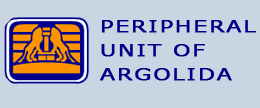Archaeological Museum
|
The Archaeological Museum is accommodated in the imposing in size as well as strict in symmetry, stone-built Venetian structure which covers and encases the central, Syntagma Square on its west side. It was first built in 1713, during the second reign of the Venetians, under the Naval Proveditore Augustine Sagredo to be used as the navy's depository, according to the marble inscription fitted on the building's frontage, written in Latin. It is widely acknowledged as one of the best well-preserved Venetian structures in the whole of Greece.
|
||
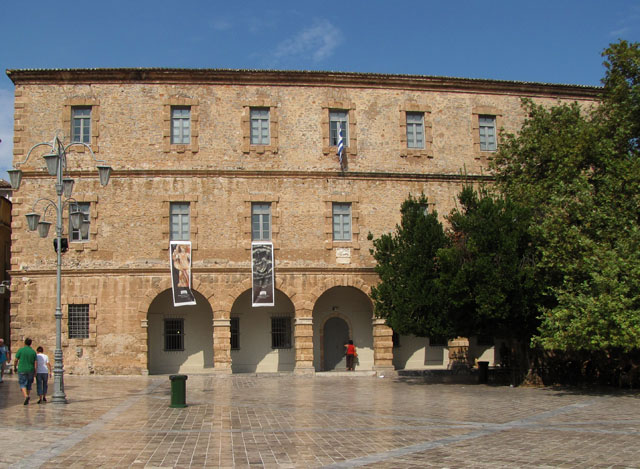 |
||
|
The permanent exhibition spreads along two halls of the same facade, within the building's two floors and is then historically divided into several themes, from the remotest pre-historical exhibit to the period of antiquity, demonstrating the walk and the mark of every civilization setting foot in Argolida Prefecture. The exhibit regarded the remotest in history here, is a Paleolithic cluster of altars (hearths) from the "Klisouras" gorge rocks or boulders in Prosymna. (32.000-21.000 BC). |
||
|
The findings of the cave "Fragthi" in Ermionida attest to the transition from hunter-gatherer to productive economy. Also, the exhibition presents stone and bone utility tools, shells and bones of animals and fish, jewelry made of shells, bones or stone, the first Neolithic pot-made jugs-vases along with a number of figurines resembling humans and animals, made of clay as well. |
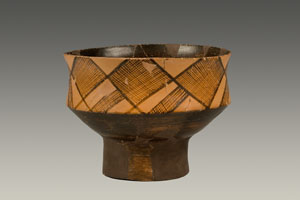
Fruit Bowl from Fragthi |
|
|
The early period of the Bronze Age or Early Helladic period (3300-2100\2000 BC) is represented with exhibits from regions such as, Tirynth, Assini, Berbati, and Ancient Epidaurus. Representative of the period's pottery is also demonstrated through seals made of stone, clay or bronze, clay sealing-tops, bone-made tools, Early-Cycladic marble figurines, a clay made hearth from Berbati region. Among them, distinctive as well as unique boasts the Tirynth cooler. Jugs, vessels and other artifices determine the Middle Helladic Period ( 2100\2000-1600 BC) from the settlements of Assini, "Pronoia" (settlement in Nafplio), Midea, Tirynth and Berbati of that period; one which was the herald, the precursor, the solid ground upon which the Mycenaean civilization would lay its foundation. The administrative edifice of the great Mycenaean Palace is depicted through findings excavated in major centers, namely in that of Tirynth, Midea and Assini, each one under the influence of Mycenae. Distinction can be offered to worshipping tools and figurines, some of which are the impressive, paddle-steamer female figurines from both Tirynth and Midea as well as the great "Lord of Assini", Linear B signs, storage amphorae (urns), workshop remainders ( casts, moulds, semi or unprocessed precious stones, half-finished artifices) together with cylindrical seal-tops, a copper-made talent (coin), pieces out of amber, faience, alabaster; all indicative of the trading channel Mycenae seemed to relish. |
||
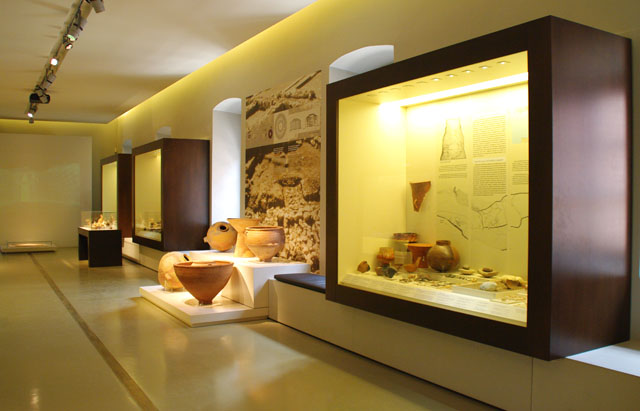 |
||
|
Following, traces and findings appear in the museum, originating from the chambers of the tombs of places such as "Church of Annunciation" in Nafplio, Assini region, Dendra village, Ancient Epidaurus place, as well as from the domed forehead of "Kazarmas". Stone, metal and clay vessels, ivory figurines, signets, jewels made of gold, semi-precious gems, amber, faience, glass, all enlightening to the burial practices, all pinpointing to the societal status quo and classism of the period. Amphorae-like craters (used to mix wine with water) are indeed eye-catching, painted with lifelike images of a chariot and a guitarist, and a longer jug, called "kalathos" or drinking-horn painted with a wild goat from the region of "Annunciation" in Nafplio town. |
||
|
The museum's most exquisite piece of archaeological finds still remains to be the Bronze Suit Armor of Dendra region, exhibited in a specially designed area together with the rest of the breathtaking tools which were excavated such as, armor equipment belonging to the soldier dressed in that armor, bronze and clay jugs.
In the hall of the second floor presentation begins with the material remains of the Iron Age. Prominently holds the bronze helmet of the famous tomb Tiryns (11th century BC.). |
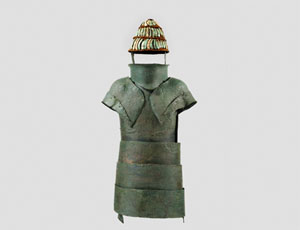 Bronze Armor from the Mycenaean tomb |
|
|
The Geometric or Homeric Era sketches itself through finds, burial tools from "Pronoia" zone, Nafplio, Tirynth, Assini and Berbati region. The horses and the horseman, perhaps of the most representative and finely designed work, does credit to the heroic aura of the time, while ceremonial drawings of dances, birds and animals compose the full picture drawn, to allow visitors to completely realize the Homeric years. Worshipping and ritualistic practices of the time are greatly presented through findings in Tirynth. The goddess Hera and the goddess Athena seem to be adulated here. Tribute is being paid to the former through throne-set deities, a shield-bearer horse rider, micrographic vessels, flowers, seeds and wreaths. To the latter, rituals included bronze helmet and tibia covering effigies-models, as well as parts of craters of the 5th century BC, with dedicatory signs to the goddess. Attracted will the eye be by the clay-made donated shields depicting mythological settings as well as the 7th century BC clay-made ritualistic masquerades, found in a place called "Vothros" of Tiryns (or Tirynth) and the copper-made "Kouros" from the region of "Kefalari" outside Argos (560-540 BC). |
||
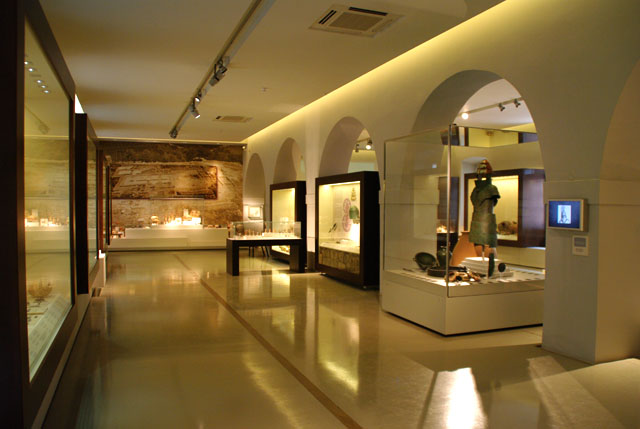 |
||
|
The thematic unit of Ancient Epidaurus, Ermioni, Alieon region, and Ancient Assini follows the course of the museum, exhibiting clay and glass vessels, figurines, gold jewelry, bronze mirrors and utensils; all depicting life and death scenes in those ancient citadels. The bronze-made statuette of a maiden (around 600BC) from Artemis sanctuary in Anc. Epidaurus stands imposing together with the Karyatides style bronze mirror (490-470 BC) from the city of Ermionis and the rusty incorporated three piece iron keys from Apollon sanctuary in Alieon region. |
||
| The tour is completed with the demonstration of a "Pyrgouthi", Berbati region homestead (6th century BC), whereby tools and utensils are being presented, related to wine- production and other agrarian tasks of the region's inhabitants.
The archaeological exhibition comes to its end with the donations to the Museum. Figurines and jugs from Attica, Viotia and Corinth are proudly revealed, gifted by collectors-donors of Glymenopoulou, Potamianou, Archbishop Nikandrou, Thermogianni families. Prestigious among others stands the pan-athenian amphora, work of the Painter of Mastos (530-520 BC). The tragic scene of the assassination of Clytemnestra by her son, Orestes is shadowed on the surface of a red shaped, Attican urn-jug (around around 440BC). A "skyphos" or cup from Viotia region,red figured Caberian, sketches a parody of the renowned fable of Odysseus's accommodation to Circe's palace. (425-400 BC). |
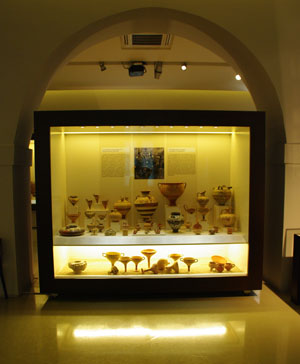 |
|
|
Evangelia Pappi |
||
| Ενδεικτικά Εκθέματα | ||
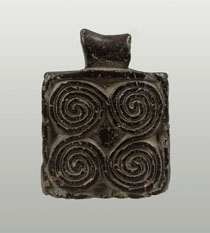 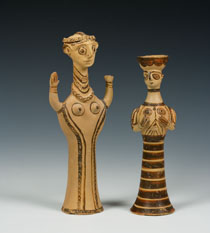 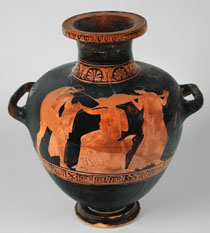 |
||
|
Soapstone seal from wheel-made Figurine of Midea goddess Red-figure hydria from Attica |
||
The museum also holds a wealth of educational-cultural programs for all age-groups. For more information, please contact our services on the following telephone number of the Museum. |
||
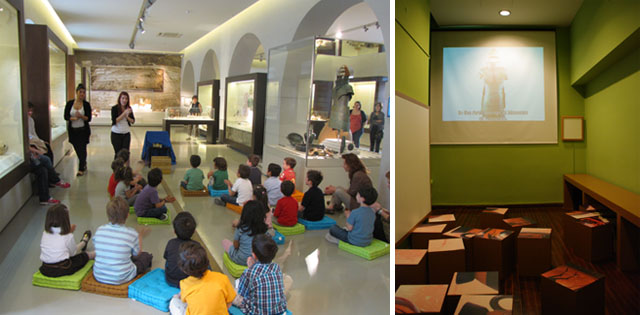 |
||
|
Τel.Number: 27520 27502 Visiting Hours: Tuesday-Sunday: 8:30-15.00 |
||



